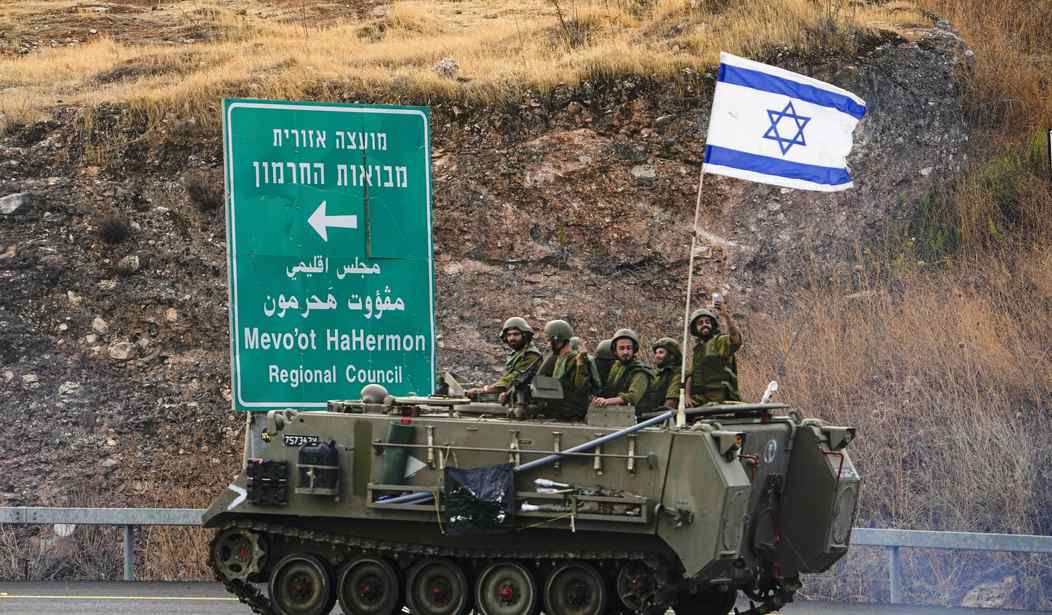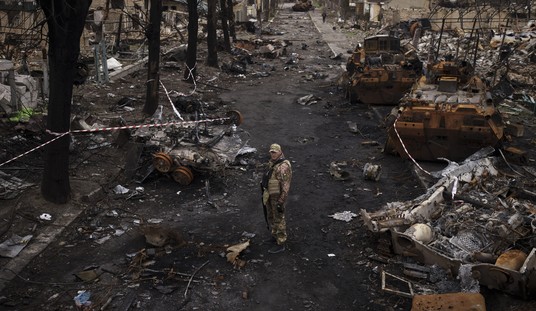So far the war against Israel hasn’t gone well for Hamas after its psychotic, barbaric murder rampage across southern Israel. One reason Hamas finds itself pinned down and about to be overrun in Gaza is the lack of effective secondary and tertiary fronts. Hamas clearly expected fellow Iranian clients Hezbollah and Syria to join the war by now, especially with Israel now clearly conducting a ground invasion — and doing so effectively.
Syria thus far seems largely uninterested in going to war so far, perhaps because Bashar al-Assad has plenty of threats to his regime already. Hezbollah has tried to at least distract Israel with missile and rocket attacks, but the IDF’s massive mobilization seems to have deterred them from a ground invasion from the north, perhaps with the two US carrier groups off their shore another powerful deterrent. And Israel’s technological advantages have mainly negated the massive missile threat from the north, at least so far.
In fact, Reuters reports that Hezbollah has lost so many soldiers already that they’re beginning to talk about dialing down the martyrdom a bit:
With dozens of Hezbollah fighters killed in three weeks of border clashes with Israel, the Lebanese group is working to stem its losses as it prepares for the possibility of a drawn-out conflict, three sources familiar with its thinking said.
The Iran-backed group has lost 47 fighters to Israeli strikes at Lebanon’s frontier since its Palestinian ally Hamas and Israel went to war on Oct. 7 – about a fifth of the number killed in a full-scale war between Hezbollah and Israel in 2006. …
One of the sources familiar with Hezbollah’s thinking told Reuters that the use of anti-aircraft missiles was one of several steps taken by the Shi’ite Muslim group to curb its losses and counter Israeli drones, which have picked off its fighters in the rocky terrain and olive groves along the border.
Hezbollah had made “arrangements to reduce the number of martyrs,” the source said, without offering further details.
The IDF reports seven killed in action in the north thus far, which makes for a very bad ratio for Hezbollah, and that’s without an attempted invasion against a reinforced, top-flight defense. Hezbollah has not used long-range rockets yet, so they are locating targets by visual means in an attempt for more precision against IDF forces in the field, and that has left them more vulnerable. If Hezbollah starts firing thousands of unguided Katyushas at Israel’s population centers, the Iron Dome system could get overwhelmed. However, it will also escalate the Israeli response against Lebanon, an outcome that could undermine Hezbollah’s political position, as well as trigger an American response to their forces in the field.
If Hezbollah’s already worried about “reduc[ing] the number of martyrs,” it sounds as though the second front Hamas needs won’t open up any time soon. The threat will still pin down significant IDF resources in the north as well as at the Golan Heights, but isn’t helping Hamas as much as they thought. The IDF clearly believes it has plenty of resources on hand to fight Hamas to the finish in Gaza.
Iran’s proxy army in Yemen has tried to get into the fight, but not with much success. The US Navy shot down missiles several days ago heading to the Red Sea, and today the IDF’s other air-defense system shot down more:
The Arrow air defense system intercepted a surface-to-surface missile launched from the “Red Sea area” at Israel, the military said Tuesday, in the first operational use of the long-range system during the war with Hamas.
The missile was believed to have been launched by the Iran-backed Houthis in Yemen, aimed for the southernmost city of Eilat.
In a statement, the Israel Defense Forces said that air force systems tracked the missile’s trajectory and intercepted it “at the most appropriate operational time and location.” …
The IDF also said fighter jets downed another two “hostile targets” — believed to be drones — that were flying in the Red Sea area during the morning.
Iran clearly wants to get involved in the war, but they’re not so clearly able to do so, at least not effectively. Their “time’s up” message on Twitter is now over a week old, and their proxies thus far are not covering themselves in glory. Iran could still directly intervene, but that has huge risks — and no guarantee of success, especially with the US Navy on hand to prevent any sustained communications with the battlefield.
Meanwhile, Israel has put aside any pretense of raids. The ground war has clearly begun in earnest now, and the IDF reports significant progress in isolating northern Gaza and encircling Hamas’ command operations:
Combined forces of the IDF, led by ground forces, have been conducting fierce battles deep in the Gaza Strip, the IDF announced on Tuesday afternoon. Dozens of terrorists have been killed.
The IDF forces attacked a Hamas terrorist outpost in the north of the Gaza Strip. A large cache of weapons was found at the site.
Israel continued ground operations overnight as it entered the twenty-fifth day of the war against Hamas. The IDF said that it had struck 300 targets overnight. This included anti-tank missile launch sites, rocket launch posts, and “military compounds inside underground tunnels belonging to the Hamas terrorist organization.”
This progress with ground forces allows the IDF to conduct combined-arms operations against Hamas, too:
“The soldiers killed terrorists and directed air forces to real-time strikes on targets and terror infrastructure,” the army explained.
For these claims, we have some corroboration from the Washington Post, in a very odd effort to “geolocate” Israeli forces in Gaza. That seems dangerous for the IDF’s forces as they fight Hamas terrorists in these locations, but #YOLO, or something:
Videos, photos and satellite images verified by The Washington Post show some of the places where Israeli tanks and troops appear to have advanced inside Gaza. These open-source visuals offer a window into what transpired as Gaza was plunged into digital darkness.
Israeli newspaper Israel Hayom posted a video Saturday that appeared to show Israeli troops occupying a beach hotel two miles inside the Gaza Strip. In the video, soldiers are seen holding an Israeli flag and the man recording refers to the scene as taking place three weeks after the “horrible crime,” referring to Hamas’s attack on Oct. 7. The video was geolocated by Younis Tirawi, who reports on Palestinian affairs, and later confirmed by The Post.
The Israeli military shared additional video Saturday that shows armored vehicles that it said entered Gaza along the northern border. New vehicle tracks in the same area were made sometime between Thursday and Saturday, according to a comparison of satellite images provided to The Post by Planet Labs. The tracks, which are roughly a mile long, appear just north of As-Saifa in the northeast corner of Gaza, not far from the Israeli border. They are identifiable by the paths that were created or widened in the area, Jamon Van Den Hoek and Corey Scher of Decentralized Damage Mapping Group, a network of scientists who use remote sensing to map the physical impacts of conflict, said after reviewing the imagery.
Fortunately, these are not real-time geolocations, and Hamas commanders probably have more pressing issues than catching up with the WaPo at the moment anyway.
Meanwhile, the New York Times appears unhappy to have been left out of the club. It took them “hours” to figure out that the ground “assault” had begun. They’re so unhappy, in fact, that they’ve even dropped the euphemistic descriptions (emphasis mine):
When Israeli ground forces advanced en masse into the Gaza Strip on Friday evening, just after the Jewish Sabbath began, they did it so secretly that it was hours before the outside world understood what had happened.
In the three days since the long-anticipated invasion began, Israel’s military has operated with a similar ambiguity, defying expectations by carrying out a more incremental ground operation than was initially anticipated. While it has continued to decimate Gaza and its people with aerial bombardments, much of the ground force appears to have hung back from Gaza City, Hamas’s stronghold in northern Gaza, and stayed instead in the countryside on the city’s fringes.
Under U.S. pressure to temper their response to the Hamas killing of more than 1,400 people on Israeli soil, Israel has even avoided describing the operation as an invasion. The loss of life, though, in Gaza continues to rise, with the Palestinian death toll so far over 8,000, according to Hamas officials.
What? Not “Gazan health ministry officials”? Isn’t that the NYT’s usual reference? This is also laughable:
“Everything is happening in darkness,” said Andreas Krieg, a war expert at King’s College, London, adding that “there’s a very small group of people who actually know what’s going on, even inside Israel.”
Well, the WaPo folks seem to know more, anyway. But seriously … how can a “war expert” express surprise over operational security and secrecy? Israel isn’t fighting a war for our entertainment, or under the approval of American media editors. They are fighting a war for their survival, made necessary by the most bloodthirsty, vicious group of marauders in civilized history. Operational secrecy and surprise are ways in which every war has been fought, at least by the winning side. Sheesh.








Join the conversation as a VIP Member